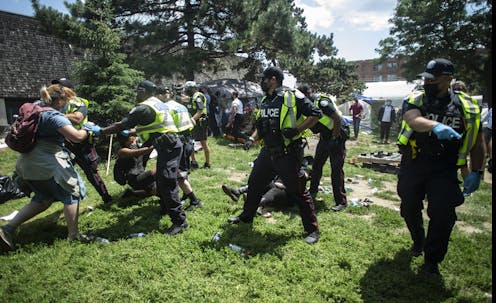
Housing affordability and homelessness are hot topics in municipal politics these days. But ironically, unhoused citizens are left out of the civic debate that most impacts their lives.
As Ontario approaches municipal elections in October, our concept of “the public” is needed to remind us of our commitment not only to the ballot box but to one another.
Toronto City Council has engaged in several heated debates this year concerning shelters, homelessness and encampments in the city. The same is true in many Canadian cities.
What comes up, again and again, are comments about “citizens” or “residents” of our cities. Much of the time, councillors, media pundits and journalists use these words to refer to people with adequate housing. Emergency shelter-hotels were unfair to “local residents.” Encampments disrupt the lives of “regular citizens.”
In a speech given during one of these debates in April 2022, Toronto Coun. Shelley Carroll asked the question: “Who is the public?”
Seats at the public table
The public is a term used to describe citizens who play a role in democratic life. Renowned political theorist Hannah Arendt explored the idea of the public based on the Athenian model of civic life and public debate.
What was crucial for Arendt — and ancient Greece — was that citizens had their most basic needs met so that they could devote time and energy to help construct a functioning society.
Arendt likened the public realm to a table, a structure shared by everyone sitting around it. All are separated and distinct entities around the table and sit in different places, but all are gathered together at that table.
At the same time, all citizens must have places to retreat to, referred to as the “private realm” by Arendt. In order to join the others at the table, there must be a place of refuge to enter from and retreat to.
I study forms of public engagement and education amid our systemic failure to house people. In doing so, I have come to realize that failures in housing are intertwined with a loss of publicness.
For years now, scholars have identified a weakened form of public life as a result of neoliberalism and a depletion of the public things all of us hold in common. It would seem that Arendt’s table is deteriorating.

Civic engagement eroded
In Ontario, critics have noted the ways in which civic engagement has been stifled as we approach the province’s municipal elections.
Those without housing are in a double bind. Not only does a lack of basic necessities preclude the freedom to engage in meaningful civic debate, but those without housing are rendered non-citizens by the contemporary political landscape. The non-citizen is judged incapable of a meaningful contribution — bound for, as Arendt would say, “the futility of individual life.”
The invention of dehousing lands us squarely in the midst of this paradox.
Dehousing refers to broad policy changes that emerged in the 1980s and ’90s. Federal cutbacks to social housing in Canada began in 1984, and by 1993, all construction of new units ceased. In comparison, the 1970s saw the construction of roughly 20,000 units annually. Management of social housing was also downloaded to the provinces in 1996.
This means these vital responsibilities were transferred to provinces like Ontario, where, in 1995, social assistance rates were cut by 21.6 per cent overnight.
Unsurprisingly, when you stop building social housing and you gut the welfare system, you create an unnatural disaster.
In a democracy, all people deserve the right to have private places from which to enter the public realm as citizens. Furthermore, if the unhoused are not recognized as residents or citizens, then they are not invited to gather together to debate the very issues that continue to exclude them.
All people deserve the right to have private places from which to enter the public realm as citizens
According to Carroll:
“The public is a pretty broad term. Some of ‘the public’ in this city has a roof over its head. Some of ‘the public’ in this city has no roof over its head.”
The media’s role
This redefining of “the public” is a helpful step toward listening to those who have experienced homelessness.
In order to conceive of unhoused citizens as members of the public, media portrayals of homelessness should rely on peer-led or participatory research that facilitates listening and understanding.
In addition, instead of highlighting the “nuisance” of individual homeless citizens, the media should generate awareness of the structural conditions that continue to perpetuate homelessness. The problems are rooted in failures of policy, not individuals.
And all citizens should pay attention to the solutions offered by those who live closest to these realities.
In Ontario’s municipal election and in all elections, Canadians should consider whether they are voting for government officials who seek to restore legitimate and adequate places of refuge for all citizens who make up our vibrant and complex public.
Timothy Martin receives funding from SSHRC.
This article was originally published on The Conversation. Read the original article.







